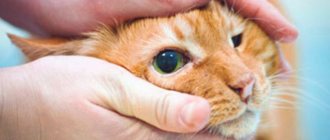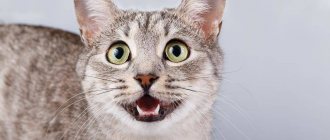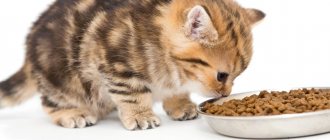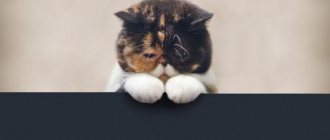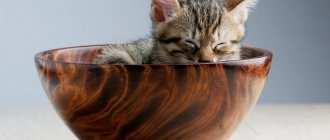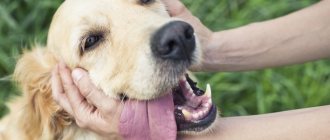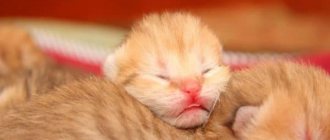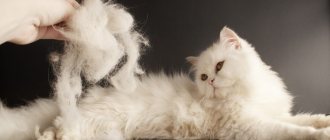The reasons why a kitten is constantly or periodically constipated can be varied. The most common include poor nutrition, progression of helminthiasis, and stress. If the problem is constantly bothering you and cannot be eliminated using usual means, it is better to visit a veterinarian who, based on the diagnostic results, can help cope with the disease. If constipation is left untreated and the disease progresses, the consequences can be unpredictable, including the death of the kitten.
Main reasons
In a newborn kitten of three weeks of age, constant problems with defecation often indicate congenital anomalies in the structure of the digestive organs. In a two-month-old baby, hard stool may indicate poor-quality nutrition or incorrectly selected foods for the first feeding. Other reasons why young kittens experience periodic or chronic constipation include:
- overeating or undereating;
- lack of fluid in the body;
- poor quality food;
- entry of a foreign object into the digestive organs;
- helminthic infestation;
- inactive lifestyle;
- kidney and liver diseases;
- neoplasms of a benign or malignant nature.
Laxatives: Top 5
- Medicines based on lactulose (“Dufolak”, “Romphalak”, “Gudalak”). The drugs can be used for a long time, the drugs are suitable for animals, have a gentle effect on intestinal motility, and are safe for health. Bowel movement occurs within 2-3 hours, taken in the morning and evening, single dose – 0.5 mg per kilogram of weight.
- Magnesium sulfate solution. The product acts on receptors in the walls of the gastrointestinal tract, effectiveness is achieved after 7-10 hours. single dose – 2-4 mg.
- “Ramnil” is a medicine made from buckthorn bark. The drug in tablet form is given to the animal once a day. A single dose is half a tablet.
- Carlsbad salt solution. The product helps improve digestion processes and leads to gentle bowel movements. Dilute a tablespoon of powder in 100 ml of water and give to the cat 2 times a day.
- “Izafenin”. Taking the powder helps cope with chronic constipation and is used as prescribed by a veterinarian.
What symptoms appear?
An animal with this problem may also suffer from bloating.
Constipation in a one-month-old kitten or an older baby is always accompanied by restless behavior of the animal. The kitten meows loudly and refuses to eat. On palpation, the abdomen is hard, swollen, filled with gases. The cat may often squat down to poop, but nothing comes out, or during defecation, a foul-smelling green slurry is released instead of feces. If you still managed to squeeze out feces, then in appearance it resembles dry peas. With such symptoms, cats require urgent medical attention; untimely treatment leads to general intoxication of the body and even the death of the baby.
Laxative for cats: the main thing
- The perceived benefit of using a laxative in a cat must be weighed against the risk of potential harm and complications;
- In case of constipation, first of all, you should remove the factor that provoked it, and only then give the cat a laxative;
- If symptoms of pain, rectal bleeding, accompanying vomiting, refusal to eat, or decreased activity occur, immediately seek veterinary help;
- Always remember that the symptoms of constipation and acute urinary retention may be similar.
First aid
Usually, at 2 months, kittens try their first complementary foods. It is the appearance of new foods in the diet that contributes to disruption of the functioning of the digestive organs. This disorder is not dangerous if you help your child cope with it in time. A universal remedy to alleviate the condition of a small cat is Vaseline oil, which is useful to drip into the mouth at the rate of 1.5 ml/kg of body weight. Any vegetable oil is immediately absorbed by the intestines, but this does not happen with Vaseline. The product lubricates the inner wall of the rectum, causing constipation to quickly go away.
To prepare a laxative, you can use condensed milk.
Sunflower oil added to dietary food also contributes to its quality digestion. In addition, you can make a portable drink from cold water and condensed milk. However, you should be careful with the amount of the drug, since in large quantities it negatively affects the condition of the liver. If these methods do not help, the baby’s belly is very swollen and the cat is in pain, you can use a microenema based on chamomile infusion or insert a small piece of laundry soap into the anus. If the condition does not improve and other pathological signs appear, it is better not to delay visiting a doctor.
Folk remedies
Effective folk remedies to relieve your cat of constipation:
Condensed milk. This remedy has a laxative effect and is safe. You will need to mix condensed milk and boiled water in equal proportions. A total of 150 ml of the mixture is needed, which should be given to the cat on an empty stomach or 1 hour after eating. There is no need to force your pet to take such a folk medicine, since animals drink this liquid with pleasure. It is enough to give the mixture once. The effect will be noticeable within a few hours. Vaseline oil. This product helps soften feces and also speeds up their evacuation from the intestines. A single dose is 0.5 ml. The oil should be given 2 times a day an hour after meals. The course of treatment should not exceed a day. Vegetable oil. To relieve constipation, you can add this product to liquid food. However, the main thing is not to overdo it, since vegetable oil is harmful to the cat’s liver. 2-3 drops once is enough. The laxative effect will manifest itself after 5–6 hours. Pumpkin. This product is considered one of the safest for pets. It is necessary to steam the pumpkin properly and add the pulp to the liquid food
It is important to mix everything thoroughly so that the cat cannot sense the presence of the vegetable. For 2 st.
l. 2 tsp of feed is enough. pumpkins. You need to mix the vegetable every day for a week. The stool should return to normal within 5–6 days. Licorice rhizome. 1 tsp. raw materials need to be poured with 200 ml of boiling water and allowed to brew for an hour. Then filter and give your pet 20 ml 2 times a day before meals for three days.
Ingredients for traditional medicine recipes - photo gallery
Condensed milk with water has a laxative effect
Licorice rhizomes stimulate intestinal function Pumpkin pulp helps improve intestinal motility Vegetable oil softens feces, promoting their movement through the intestines
What treatment is prescribed?
Effective drugs
The following remedies will help cure constipation in small cats:
- "Duphalac". The main component of the drug is lactulose, which is very effective for problems with stool. The individual dosage should be obtained from your veterinarian.
- "Espumizan". Completely harmless to animals. Helps eliminate gases and flatulence.
- "Festal". Normalizes the production of enzymes, thereby improving digestion.
- "Bifidumbacterin". An additive that will help to multiply beneficial microflora in the intestines.
Microclysters
You can rinse the animal's intestines using the smallest syringe.
To prevent the kitten from suffering from abdominal pain, it is recommended to give it an enema. To do this, use the smallest enema. The composition of the solution can be varied, but the following are often prepared:
- chamomile infusion;
- soapy water;
- mineral oil solution;
- regular cool water.
The sequence of the procedure is as follows:
- Place the kitten in a basin, bathtub or other container, the main thing is that it can then be easily cleaned of feces.
- Securely secure the animal in a standing position.
- Lubricate the tip of the syringe with Vaseline, then carefully insert it into the anus.
- It is important to squeeze out the water carefully so as not to cause pain to the baby. The effect comes instantly.
Veterinarians advise doing an enema in the morning, immediately after sleep and before feeding, while the small pet is still relaxed.
Abdominal massage
It is advisable to conduct such sessions daily so that the baby does not have tummy problems.
You can massage your pet at home. If the cat was brought into the house before the age of 3 months, it is useful to carry out massage procedures regularly, which helps stimulate the functioning of the internal organs. For constipation, stroking movements not only improve peristalsis, they also act as a pain reliever. It will be possible to improve digestion if you do light strokes 3-4 times every day for 7-10 minutes.
Folk remedies
If a one-week-old kitten is constipated, you can give him condensed milk diluted in cool water as a laxative. No less effective is Vaseline oil, which is not digested in the stomach and is not absorbed in the intestines, due to which dense stool is well lubricated in the rectum and easily comes out. However, it is worth remembering that if the pet does not feel better within 1-2 days and home remedies are ineffective, it is necessary to urgently take the cat to the hospital so that it does not die from intoxication and other complications.
What to feed?
To avoid such a problem, a suitable milk formula is selected for the baby.
The diet of a kitten suffering from frequent constipation is compiled by a veterinarian, taking into account the cause of digestive problems, age, and other individual characteristics of the body. If the baby is not yet 2 months old, the basis of the diet should consist of a special milk formula, liquid oatmeal or semolina. Older pets are allowed to diversify their menu with cottage cheese, kefir, and chopped boiled chicken. An adult 6-month-old kitten is transferred to a more expanded diet, including various cereals, fish, vegetables, fruits, and eggs. If a cat eats ready-made factory food, it is better to buy it a premium and super-premium product. Cheap food does not provide the body with the necessary substances and, at the same time, disrupts the functioning of the digestive system.
Symptoms of constipation in cats
Constipation is considered a situation when an animal does not have a bowel movement for more than 3 days. Normally, adult cats should go to the toilet most times a day. Kittens digest food faster due to their increased metabolism. Therefore, the norm for them is 1-2 times a day. Elderly pets over 6 years old, whose metabolic processes are reduced, can go once every two days.
Doctors recommend paying attention to the condition of the animal's feces regularly. In a healthy pet, the mass is soft, shiny, dark brown, and oblong in shape. If the consistency of the feces is dry or, on the contrary, liquid, has inclusions, or an unusual color, this is a signal that something is wrong with the animal.
Cats may have complete stool retention, when no stool comes out at all, or partial, when the stool comes out in a minimal amount, most of it remains in the intestines.
This is usually associated with various diseases, so you should pay attention to additional symptoms of constipation. If a pet screams when defecating, does not allow pressure on its stomach or even stroking it strongly, then this may be a symptom of mechanical damage to the pelvic organs, diseases of the internal organs, or gastroenteritis.
If the animal often visits the litter box, but the feces have a liquid consistency, then are replaced by dry ones, or they are not present at all, or they come out in small portions, perhaps we are talking about enterocolitis, gastroenterocolitis.
What to do for prevention?
The owner who takes a four-legged baby into his home must understand that the health and proper development of the pet’s body depends on proper care and maintenance. If the kitten has ever had digestive problems and was bothered by constipation, after eliminating the disease, it is necessary to continue to constantly monitor so that this does not happen again.
As a preventive measure, veterinarians advise reviewing the animal’s diet and excluding from it foods that are prohibited for the cat’s body. It is best to switch your pet to ready-made food, which will help solve the problem of constipation. In addition, do not forget about drinking regime, physical activity, timely treatment of various diseases and scheduled preventive visits to the veterinarian.
If your kitten is constipated: what to look for
In this article we will not consider the causes of this pathological condition, but we note that most often the pathology is in one way or another connected with the nutritional characteristics (including the mother of the kittens).
Before starting any active actions, it is necessary to analyze the following nuances:
- When exactly and after what did the pet stop defecating?
- How long has this been going on?
- Were antiparasitic treatments carried out, and when, in particular, was the last one?
- Has the baby’s diet changed recently, and has this happened too abruptly?
All of the above will certainly help to quickly identify the causes of constipation. In addition, we recommend contacting your veterinarian immediately if:
- The kitten not only strains, but also constantly, pitifully meows.
- The excreted pieces of feces show abundant clots of blood and mucus.
- Palpation of the abdomen reveals severe tension in the abdominal wall and pain.
- Also, the help of a specialist will not hurt if the kitten has not pooped for more than three days.
If you experience bloating due to constipation, you should not self-medicate.
This sign often indicates one of two most dangerous pathologies:
- Or is it a foreign body in the intestines.
- Or full-fledged coprostasis, which is impossible to cure at home.
If in these cases you try to “help” the pet by giving it drugs that enhance intestinal motility, then the kitten will most likely die from intestinal rupture . So, if there is severe bloating, you should immediately call a veterinarian, without wasting time on dangerous attempts at self-medication.
What to do at home: the main tasks of the owner
The first priority is to provide your pet with an unlimited amount of clean drinking water. The more the baby drinks, the better the semi-dry stool in the intestines will be moistened, and the greater the chance of coping with constipation on its own.
If the kitten does not drink, or his thirst is not very pronounced, you will have to force him to drink. In such cases, we strongly recommend that you immediately seek help from a veterinarian, as your pet will almost certainly require intravenous fluids.
The second most important task of the owner is to create a diet enriched with dietary fiber that stimulates intestinal motility. In addition, it is necessary to create a strict feeding schedule that will help return the kitten's digestive system to normal.
To do this, you can use two simple folk remedies: pumpkin puree and bran. It is best to use puree, since its sweetish taste and pleasant consistency do not cause rejection in the animal, and therefore the baby does not have to be force-fed. A kitten can be given up to one teaspoon of this product per day.
You should not overdo it, as in this case you can achieve the exact opposite result (i.e. constipation will be replaced by diarrhea, which is even more dangerous for the kitten).
You need to be careful with bran when treating constipation in kittens, as it can severely irritate your pet’s digestive tract. Be sure to consult your veterinarian when adding any nutritional supplements to your kitten's diet!
You need to play with the kitten more often. Don’t forget that physical activity is the key to an animal’s health (and more). The more active the pet runs and jumps, the more active the peristalsis of its intestines will be.
We do not recommend playing with your baby if he has recently eaten.
- First, it can make constipation worse.
- Secondly, physical activity with a tightly full stomach greatly increases the risk of volvulus and death.
Finally, you need to regularly and carefully observe your pet, noting any oddities in its behavior. If, despite the owner's best efforts, the animal's condition does not improve within two days or more, consultation with a veterinarian is necessary.
Elimination of acute postoperative constipation
What can cause a cat to develop persistent acute constipation immediately after surgery? There are several reasons for this.
- Firstly, due to anesthesia, the innervation of the intestine is disrupted (in any case, it may be disrupted), which causes its peristaltic activity to deteriorate. Accordingly, it becomes difficult to remove feces from the body.
- Secondly, for some reason many breeders are firmly convinced that the pet must be fed “to its fullest” immediately after it comes out of anesthesia. Since her gastrointestinal tract does not function well during this period, food is not properly digested, and stagnation occurs.
- Finally, any operation is a serious stress for the body, and doctors and veterinarians have known about the ability of stress factors to inhibit peristalsis for a very long time.
Many people often believe that there is nothing wrong with constipation. This is a dangerous misconception. In fact, this pathology is very dangerous for the health and even life of your pet (especially in the postoperative period).
The point is that the accumulation of feces in the intestines is a constant source of a huge amount of toxins.
When absorbed into the blood, these compounds cause chronic intoxication, which causes liver and kidney failure in particularly “lucky” animals. Considering that after an operation performed under anesthesia, the kidneys and liver are already quite overloaded, persistent constipation can be fatal. Moreover, in some cases, new surgery may be required to eliminate it. And it is not a fact that the body of a sterilized animal will endure the consequences of a new surgical intervention.
Thus, there is no point in bringing things to such “side effects”. Fortunately, acute constipation, if timely measures are taken to eliminate it, can be cured quite quickly.
Treatment in such cases is carried out according to a typical scenario:
- Increase the daily volume of water, including increasing the percentage of wet, canned food in the diet.
- Suppositories are administered rectally.
- If they do not help, use enemas with Vaseline or olive oil.
- To prevent dehydration and eliminate signs of intoxication, Ringer's solutions, glucose, or simple saline are administered intravenously.
Particular attention should be paid to increasing the water supply, since all constipation is to one degree or another associated with dehydration. To make the water more attractive to your cat, you can add a little liquid from canned fish to it. Of course, drinks with such additives need to be changed much more often, otherwise your pet risks getting an upset stomach.
Candles
Please note that you can only use (!) glycerin suppositories to treat cats yourself without any medicinal “fillers”. But ideally, even in this case, a preliminary consultation with a veterinarian is required! In any case, it doesn’t hurt to call a specialist and find out exactly how to administer the suppository.
If you can’t get through, use our tips:
- Glycerin suppositories are available not only for children, but also for adults. In the first case, a whole suppository can be administered to an adult pet (for a kitten it must be divided in half), in the second case, the suppository should be cut in half (for kittens, ¼ is administered, respectively).
- In order not to cause pain and other unpleasant sensations to your pet, the cut edges of the candle are carefully aligned with a knife.
Before using the medicine, it is better to place your pet on its side. When you “wrap” the suppository into his anus (and you should actually insert the suppository with twisting movements), be sure to hold your finger, slightly pressing it into the cat’s anus. Since this is not a very hygienic event, we recommend using disposable medical gloves. Please also note that with mild to moderate constipation, your pet can “wholesale” release all the accumulated feces, so it is better to carry out the procedure itself in the bathroom or simply lay some kind of unnecessary rag under it.
Enemas
Before using an enema, remember one simple fact - you don’t need to think that to eliminate constipation in a cat you need to inject liters of water into the rectum!
10 ml of water-oil emulsion is quite enough. To prepare, oil (vaseline or purified olive/sunflower) and water (boiled and warm) are taken in a 1:1 ratio.
You can use ready-made microenemas (Microlax, for example), but we strongly advise you to consult a veterinarian before using them!
Symptoms of the problem
If your pet begins to visit the litter box less often than usual, watch him. For behavioral reasons associated with stale filler, it will regularly make piles in the wrong place. Don't scold your pet for this and change the tray more often. Clean animals rarely walk past their toilet. When an unpleasant odor appears, they can meow loudly, calling on the owner to solve the problem. Be attentive to such situations.
A serious pathology can be indicated when accompanying symptoms appear, including:
- painful and swollen abdomen;
- vomit;
- temperature increase;
- depression and refusal to eat;
- prolonged stay in the tray, accompanied by plaintive meowing;
- mucus or blood in the stool, changes in its color and consistency;
- the presence of blood on the anus or its swelling caused by trauma to the rectum.
The absence of bowel movements, followed by periodic diarrhea, is a sign of enterocolitis, that is, simultaneous inflammation in the small intestine and rectum. Only a doctor can make an accurate diagnosis. After detecting the listed symptoms, be sure to make an appointment with a veterinary clinic.
Why is constipation dangerous?
Constipation is extremely dangerous for an animal for a number of reasons. Even if we do not take into account the fact that they may indicate some more serious problems, they cause real harm to the cat’s body. The biggest danger is the accumulation of feces, which causes gradual intoxication with decay products. When the intestines rupture, everything happens even faster, and feces cause blood poisoning, which is almost impossible to cope with even with surgery.
